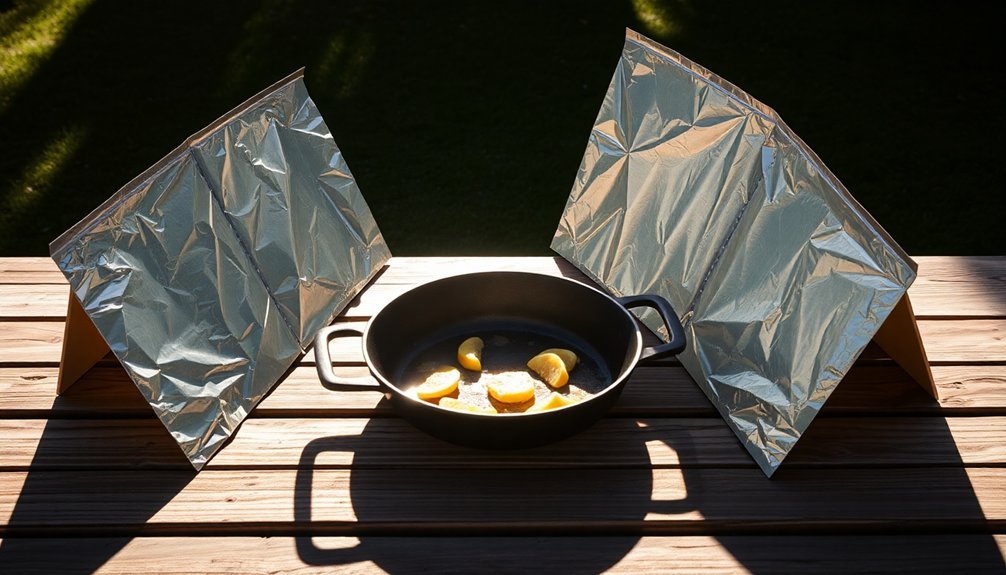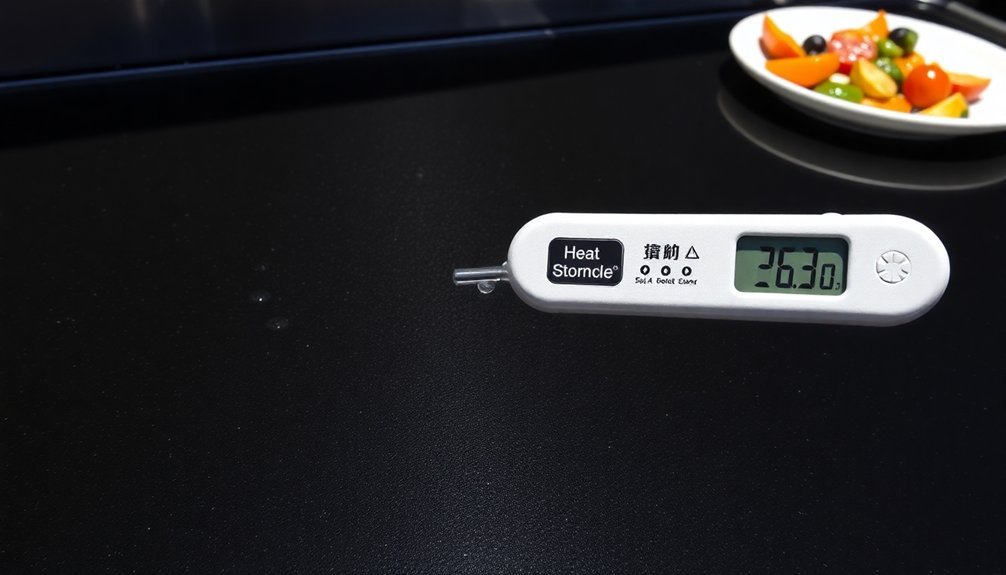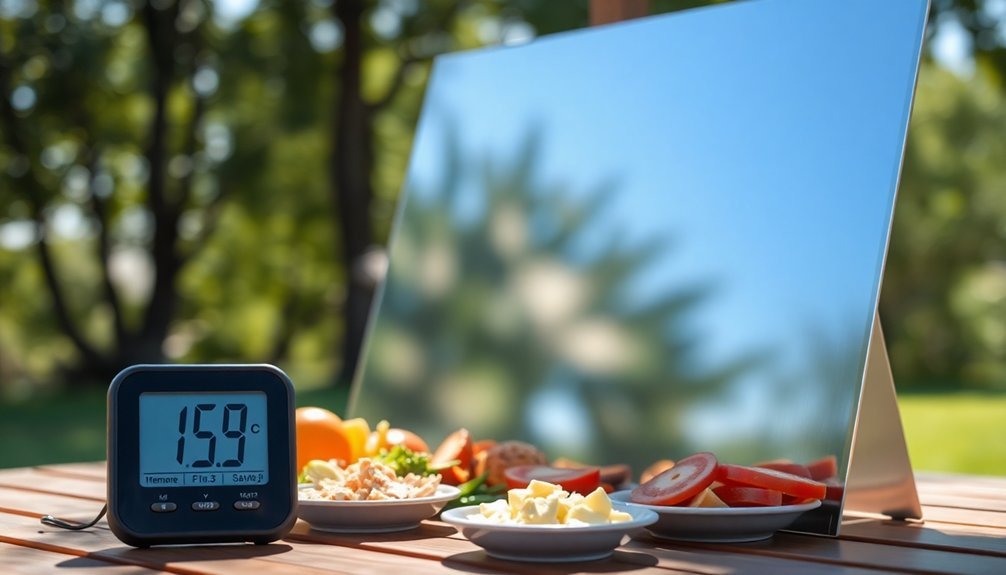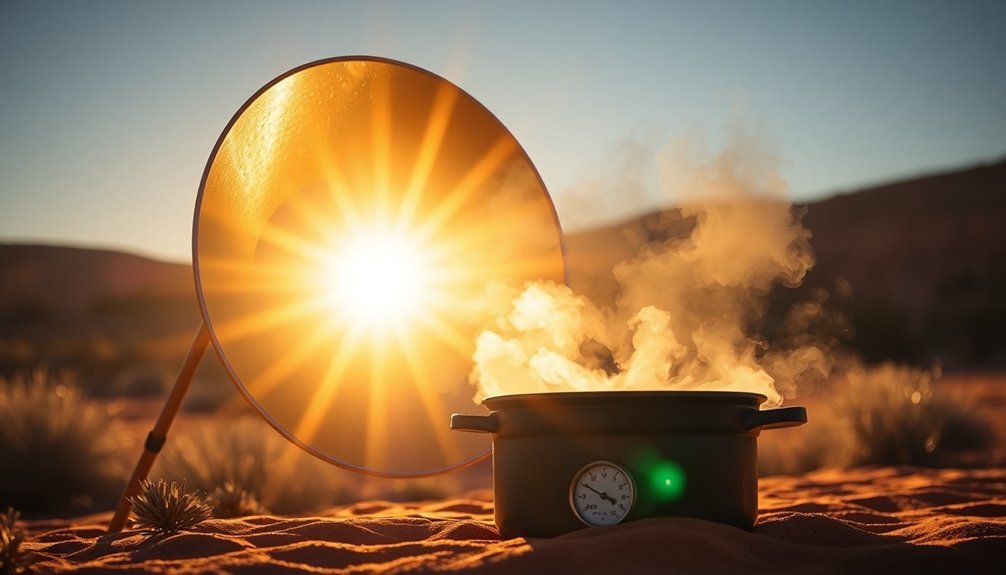Keep your outdoor meals piping hot with five proven heat reflection methods. You'll maximize warmth by strategically positioning aluminum foil as windbreaks and reflectors around your cooking area. Create a greenhouse effect by using plastic wrap to trap heat while letting sunlight through. Incorporate black surfaces in your setup to absorb and maintain heat more efficiently. Apply multi-layer insulation techniques with sealed seams to prevent heat loss. Position your dining area with southern exposure and use angled reflective surfaces to capture ideal sunlight. These science-backed techniques are just the beginning of mastering outdoor temperature control.
Strategic Aluminum Foil Placement

While aluminum foil can be a valuable tool for outdoor cooking, you'll need to use it strategically to maximize its heat-reflecting benefits. You can mold the foil into a cone or box shape to harness and redirect radiant heat from your campfire, creating an efficient cooking environment.
When setting up your cooking area, position foil sheets as windbreaks to protect your fire from gusts that could affect its performance. The reflective surface won't just block wind—it'll bounce heat back toward your cooking space, establishing a protected microclimate that helps maintain consistent temperatures. Line tent walls with foil for additional insulation against cold temperatures.
However, don't let foil directly contact your hot food, as aluminum can leach into meals at high temperatures. Instead, use it solely for heat reflection and wind protection, opting for safer alternatives like wax paper or glass containers for food storage.
Maximizing The Greenhouse Effect
Beyond aluminum foil's reflective properties, you can harness the sun's power through the greenhouse effect to create an efficient outdoor cooking environment.
By covering your solar oven with plastic wrap, you'll trap heat inside while allowing sunlight to enter, just like greenhouse gases in Earth's atmosphere. This approach helps mitigate heat islands in urban areas, similar to how urban farms help cool cities.
You'll want to verify the plastic wrap creates a tight seal over the opening to maximize heat retention. This transparent layer, combined with black paper inside the box, can raise temperatures by 30°F in just 10 minutes of direct sunlight.
The trapped heat creates convection currents where hot air rises, cools, and sinks back down, distributing warmth evenly throughout your cooking space.
Even on cloudy days, you can still cook food using this method, though it'll take longer.
Black Surface Heat Absorption

Since black surfaces excel at absorbing thermal radiation, they're essential for maximizing heat in outdoor cooking setups. You'll find that black surfaces convert sunlight into heat more efficiently than any other color, making them perfect for solar cooking applications and heat retention in outdoor meal preparation. The scientific reason behind this efficiency is that higher energy electrons make black surfaces superior at light absorption.
- Dark-colored cooking surfaces can greatly increase your food's heating rate.
- Black containers and cookware will maintain higher temperatures longer.
- Using black materials in your outdoor kitchen setup helps optimize energy absorption.
When you're planning your outdoor cooking area, consider incorporating black surfaces strategically. You can wrap containers in black paper, use dark-colored cookware, or install black heating panels to take advantage of this natural heat absorption property.
However, be cautious with black clothing while cooking outdoors, as it can make you uncomfortably warm in hot weather.
Multi-Layer Heat Insulation Techniques
Building on the principles of heat absorption, multi-layer insulation takes outdoor meal temperature control to the next level.
You'll find that incorporating multiple layers in your food packaging creates a powerful defense against temperature changes.
Start by using double-layer construction with insulating materials like EPS foam or aerogels between layers.
You'll want to guarantee each layer is mechanically isolated from the next to prevent thermal short circuits.
For maximum effectiveness, add reflective foil technology to the interior lining – it'll bounce radiant heat back to your food.
Don't forget to check that your seams are properly sealed to maintain insulation integrity.
Proper thermal bag design can significantly enhance temperature retention through strategic layering of closed-cell foam and reflective materials.
If you're dealing with specific foods like pizzas or soups, you can customize your layering approach using vacuum-insulated panels or phase change materials for ideal temperature retention.
Optimal Sun Angle Positioning

When planning your outdoor dining setup, understanding ideal sun angles can dramatically improve both comfort and food temperature control. Consider positioning your dining area with a southern exposure to maximize natural warmth, while incorporating adjustable shade options for temperature regulation.
Key factors to optimize your sun positioning:
- Place taller structures or plants on the north side to prevent unwanted shadows over your dining space.
- Use reflective surfaces like mirrors or metallic panels angled at 45° to redirect sunlight where needed.
- Position wind barriers to protect from cooling breezes while maintaining proper ventilation.
You'll want to observe how sunlight moves across your space throughout the day. If you're using solar cooking methods, verify your setup includes pivoting reflectors that can track the sun's movement for consistent heating power.
Frequently Asked Questions
Can Solar Ovens Effectively Cook Meat Without Risking Foodborne Illness?
Yes, you can safely cook meat in solar ovens that maintain 200-300°F temperatures. You'll need to monitor internal temperatures with a probe thermometer and guarantee meat reaches required safety levels: 145-165°F depending on type.
How Do Different Weather Conditions Affect Solar Oven Cooking Times?
Your solar cooking times will vary: clouds can double cooking duration, strong winds reduce efficiency, and you'll get ideal results between 11am-3pm on clear days near the equator.
What Alternative Materials Can Replace Aluminum Foil for Reflection?
You can use metalized plastic sheets, double-bubble reflective insulation, or foil-coated bubble wrap instead of aluminum foil. These materials effectively reflect heat and are often more durable than standard foil.
How Long Does a Typical Solar-Cooked Meal Take Compared to Conventional Cooking?
You'll need to plan for 1.5 to 3 times longer than conventional cooking. A meal that takes 1 hour on your stovetop might require 2-3 hours in a solar cooker.
Is It Safe to Use Recycled Materials When Building a Solar Oven?
You can safely use recycled materials for your solar oven if they're clean and undamaged. Avoid materials with chemicals, like treated wood or certain plastics. Always inspect pizza boxes and aluminum foil for contamination.
In Summary
You've now learned five effective methods to harness and control heat during your outdoor dining. Whether you're using aluminum foil strategically, creating greenhouse conditions, utilizing black surfaces, implementing multi-layer insulation, or positioning your setup at best sun angles, you'll keep food at ideal temperatures. Try combining these techniques for even better results, and don't forget to adjust your approach based on the weather conditions.





Leave a Reply